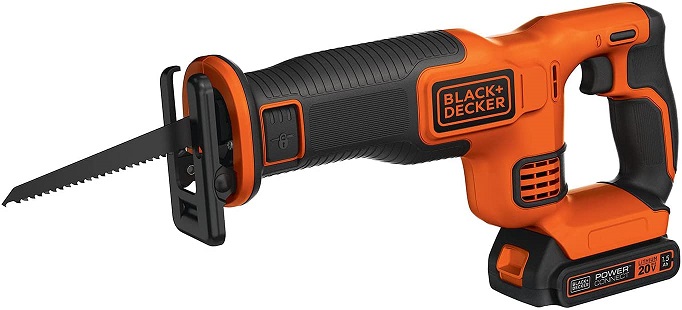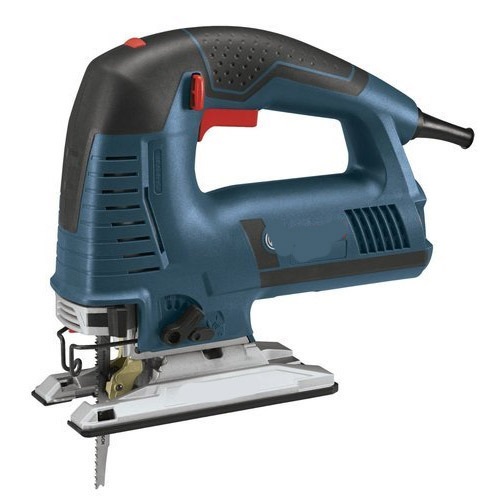Ideal for demolition purposes, remodeling jobs, and renovation, a reciprocating saw lets you use it for different purposes. It comes in the form of a heavy-duty tool that has a large reciprocating blade. A reciprocating saw features a trigger mechanism and is available in a handheld design.
You will easily find the one that can come in a corded and cordless design. However, both the designs have their own merits and demerits. The brutally powerful tool can cut through tough materials like metal, bricks, masonry, and hardwood. With its horizontal blade, it can reciprocate the movement. The saw can cut in back and forth motion or push and pull motion.
Outline
TogglePros and Cons Of Reciprocating Saw –
Here are the advantages and drawbacks of Reciprocating Saw.
Pros
- Comes in a lightweight and portable design.
- Often features variable speed.
- Ability to provide adjustable stroke length.
- Stabilized components for better safety.
- Ideal for overhead cutting.
- Easy to use.
- Ability to cut horizontally and vertically.
- Ideal for a wide range of materials.
- Can be used for versatile purposes.
- Option to choose from both corded and cordless designs.
Cons
- It can give rough cuttings.
- Not suitable for intricate cutting purposes.
What Is The Application of Reciprocating Saw?
A reciprocating saw is ideal for demolition works. As a versatile tool, it lets you use it for cutting different materials including wood and ceramic. This makes it perfect for different purposes like remodeling jobs, plumbing jobs, and electrical jobs. The purpose of a reciprocating saw can be perfect for projects that need immense cutting power.
How Does A Reciprocating Saw Operate?
As the name indicates, a reciprocating saw utilizes reciprocating motion. It has a similar operation to a chainsaw and looks like a hacksaw. However, the blades move in forwarding and backward motion. In a reciprocating saw, the blade is a few inches long. You can easily exchange the blade to use it for different materials. Often, you can change the speed.
What Is A Jigsaw?
Available in the form of a handheld power tool, a jigsaw lets you use it for cutting different materials like metal, wood, and plastic. It features vertical blades where the motor moves up and down. With it, you can cut in different shapes and patterns. It is a type of reciprocating saw that pushes and pulls for cutting through the surface.
However, there are many differences between the two. The blade protrudes downwards from the saw. Compared to a reciprocating saw, it lets you use it with a single hand. You will also find a jigsaw in both corded and cordless models. In comparison to the reciprocating saw, it is not so powerful.
Also check –
Pros and Cons Of Jigsaw –
Here are the advantages and drawbacks of jigsaw that you should be aware of.
Pros
- Available in a lightweight design.
- Ideal for different purposes,
- It can cut different types of materials including wood, plastic, ceramic tiles, and thin metal.
- Easy to use.
- Provide precise cuts for cross cuts, curved cuts, plunge cutting, and ripping.
- Available in both corded and cordless designs.
Cons
- Not suitable for heavy duty jobs.
- Does not provide the best flush cuts.
What Is The Application of Jigsaw?
With a jigsaw, there will be precise cutting. There will be more finesse while completing the job. A jigsaw features a small and thin blade that makes up and down movement. You can easily use it for small jobs including stencil cutting. Similar to a circular saw, jigsaw blades also let you switch and replace them. This makes it ideal for a variety of projects. However, it does not have much power for large projects. Despite saying this, you can easily use it for cutting materials like concrete.
How Does A Jigsaw Operate?
In comparison to other blades, jigsaws work differently. As it comes with vertically installed blades, it is fed into the shaft which again gets controlled by the motor. This helps to create an up-and-down movement. Often you can find the models that can come with variable cutting speeds. You can even go for blade replacements and swap one for choosing between metal or wood.
Comparison Chart For Jigsaw Vs Reciprocating Saw:
| Jigsaw | Reciprocating Saw | |
| Power | 3 to 4 amps. | Minimum 5 amps. |
| Safety | Care is required. | Requires extreme caution. |
| Application | Plastic housing.
Cutting intricate shapes on different materials. Cutting and rounding of edges. |
Pruning trees.
Cutting window and door frames. Drywall and metal cutting. |
| Accuracy | Moderate | No accuracy. |
| Maximum Cutting Depth | 2.25-inch on softwood. | 3.375-inch on softwood. |
| Design | Perpendicular blade | Protruding blade |
| Blade | U-shank or T-shank. | Large |
What Are The Differences Between Reciprocating Saw And Jigsaw?
There are a lot of differences between a reciprocating saw and a jigsaw. If we have to discuss the application, you can use a reciprocating saw for heavy-duty tasks. On the contrary, a jigsaw can be great for light to medium tasks. Here are the main differences between a reciprocating saw and a jigsaw
Power: A reciprocating saw is very powerful. This makes it suitable for heavy duty jobs. A jigsaw on the other hand comes with moderate power. You can use it for medium to light tasks
Accuracy: When it comes to accuracy, a reciprocating saw is a rough tool. It does not offer better accuracy. However, a jigsaw offers moderate accuracy. This does not mean that it can provide precise cuts.
Blade: In a reciprocating saw, you will find relatively larger blades. These blades can handle different types of materials and can be great for pruning trees or cutting through metal or drywall. A jigsaw comes with U-shank or T-shank blades. This helps to create intricate shapes on different types of materials.
Design: While a reciprocating saw has a blade that protrudes straight out, a jigsaw features a blade that is perpendicular to the base.
Safety: If you have to compare the safety, then both require caution. However, a reciprocating saw can be dangerous and requires extreme caution. You must always handle a jigsaw with care.
Conclusion
The above article describes reciprocating saws and jigsaws along with their comparison. With a jigsaw, you will be able to create precise cuts with better accuracy. However, it is not as powerful as a reciprocating saw. You can use a reciprocating saw for destruction and demolition. It all boils down to your usage and getting the right type of saw.



